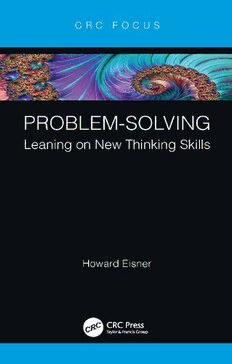
Problem-Solving: Leaning on New Thinking Skills PDF
Preview Problem-Solving: Leaning on New Thinking Skills
Problem-Solving Problem-Solving Leaning on New Thinking Skills Howard Eisner First edition published 2021 by CRC Press 6000 Broken Sound Parkway NW, Suite 300, Boca Raton, FL 33487-2742 and by CRC Press 2 Park Square, Milton Park, Abingdon, Oxon, OX14 4RN © 2021 Howard Eisner CRC Press is an imprint of Taylor & Francis Group, LLC Reasonable efforts have been made to publish reliable data and information, but the author and publisher cannot assume responsibility for the validity of all materials or the consequences of their use. The authors and publishers have attempted to trace the copyright holders of all material reproduced in this publication and apologize to copyright holders if permission to publish in this form has not been obtained. If any copyright material has not been acknowledged please write and let us know so we may rectify in any future reprint. Except as permitted under U.S. Copyright Law, no part of this book may be reprinted, reproduced, transmitted, or utilized in any form by any electronic, mechanical, or other means, now known or hereafter invented, including photocopying, microfilming, and recording, or in any information storage or retrieval system, without written permission from the publishers. For permission to photocopy or use material electronically from this work, access www. copyright.com or contact the Copyright Clearance Center, Inc. (CCC), 222 Rosewood Drive, Danvers, MA 01923, 978-750-8400. For works that are not available on CCC please contact [email protected] Trademark notice: Product or corporate names may be trademarks or registered trademarks and are used only for identification and explanation without intent to infringe. Library of Congress Cataloging‑in‑Publication Data Names: Eisner, Howard, 1935- author. Title: Problem-solving : leaning on new thinking skills / Howard Eisner. Description: First edition. | Boca Raton, FL : CRC Press, 2021. | Includes bibliographical references and index. | Summary: “This book presents various methods of problem-solving that can be adapted to any field. It focuses on a set of a dozen new approaches with an ending result to finding better solutions to problems that you may have previously found difficult. The book discusses problem-solving based upon new thinking skills and presents the relationship between problem-solving and creativity. A connection between problem-solving and re-engineering is presented as the book explores the ability to tackle new and difficult problems in all aspects of life. Target audience is general engineers, systems engineers, scientists, technologists, mathematicians, and lawyers”— Provided by publisher. Identifiers: LCCN 2021004488 | ISBN 9780367749811 (hbk) | ISBN 9780367749828 (pbk) | ISBN 9781003160618 (ebk) Subjects: LCSH: Problem solving. | Creative thinking. Classification: LCC T57.95 .E43 2021 | DDC 153.4/3—dc23 LC record available at https://lccn.loc.gov/2021004488 ISBN: 978-0-367-74981-1 (hbk) ISBN: 978-0-367-74982-8 (pbk) ISBN: 978-1-003-16061-8 (ebk) Typeset in Times by codeMantra This book is dedicated to my wife, June Linowitz. She shows infinite patience with me as I age. So do my son Oren and daughter Susan. And those married to them – Tara and Joseph. And also my five grandchildren – Jacob, Gabriel, Lee, Zachary and Ben. They all have helped me with my attempts at problem solving, and discovering new ways to approach problem solving. What could be better than hearing – can I help you with that Grandpa? Contents Preface xiii Author xv 1 The Nature of Problem-Solving 1 Five Large-Scale Problems 2 Predatory Pricing 2 Getting Through College 3 The Climate Issue 3 Cybersecurity 4 The Crisis in IT (Information Technology) 4 Problems from the Author’s Experience 5 Problems for the Systems Engineer 8 Top Department of Defense (DoD) Management Problems 9 Overall Concept of This Treatise 9 Generic Stepwise Approach to Problem-Solving 10 Solving Problems is Our Primary Focus; Thinking Supports 11 Exercises 12 References 12 2 Thinking as a Corporate Culture 13 Thinking as Necessary in Problem-Solving 14 The Learning Organization 14 Moving on to Hewlett-Packard 15 Design Thinking – Change by Design 16 Annual Reports 17 Xerox 17 Amazon 18 Microsoft 18 SAS (Institute) 19 Northrop Grumman 19 Alphabet (Google) 19 Intel 20 Lockheed Martin 21 Apple 21 General Dynamics 22 vii viii Contents Raytheon 22 Leidos 22 Themes 23 Exercises 23 References 24 3 The Power of the Idea 25 Innovation Revisited 25 Better Idea Stories 26 Netflix 26 IBM: Watson, Sr. and Jr. 26 Xerox 27 Apple 27 Amazon 27 Facebook 28 Google (Alphabet) 28 Oracle 28 SAS 28 FedEx 29 A Group of Generic “Problems” and “Solutions” 29 Blockbuster and Netflix 29 Industry and the DoD 29 What Business Are We In? 30 IBM and Microsoft 30 Dr. Deming and Japan and the US 31 Xerox PARC and Steve Jobs 31 Saul Steinberg and Leasco 31 Coke/Classic Coke, Old Taste 32 Good Idea, Failed Follow-Through 32 Acronym for the Individual with Potentially Better Idea 32 Exercises 33 References 33 4 Approaches to Problem-Solving 35 The “N step” Disciplines 35 Technical Decomposition/Reductionist 36 Modeling and Simulation 37 Lateral Thinking and (Lateral) Problem-Solving 38 Total Systems Intervention 39 Generalized/Systems Approach 40 Design Approach 41 Expert Systems 41 Contents ix Definitive Mathematics and Statistics-Based Methods 42 Statistics-Based Approach 43 DoD-Suggested 43 How is That for Out-of-the-Box Thinking? 45 Decision Support Systems 45 Cost-Effectiveness Analysis 46 Exercises 47 References 47 5 Think Tanks and Problem-Solving 49 Federally Funded R&D Centers 49 Systems Engineering Research Centers 50 The MITRE Corporation 51 MITRE Awards over the Years 52 The Aerospace Corporation 52 The RAND Corporation 53 ANSER 54 IDA 55 CNA 56 Energy National Labs 57 Exercises 57 References 57 6 Specific Problems and Their Solutions 59 The Coin Weighing Problem 60 Types of Algorithms 60 The Kalman Filter 61 The Minimum Computer Step Problem 62 The Matchstick Problem 62 The Efficient Message Coding Problem 63 The River-Crossing Problem 63 Parameter Dependency Diagramming 64 The National Aviation System 64 A Radar Submodel 65 An Optimal Search 66 Laplace and Fourier Transforms 67 Lagrange Multipliers 67 Allocation of Requirements Errors 68 A Walk in the Park 68 The Bottom Line 69 Exercises 69 References 69
